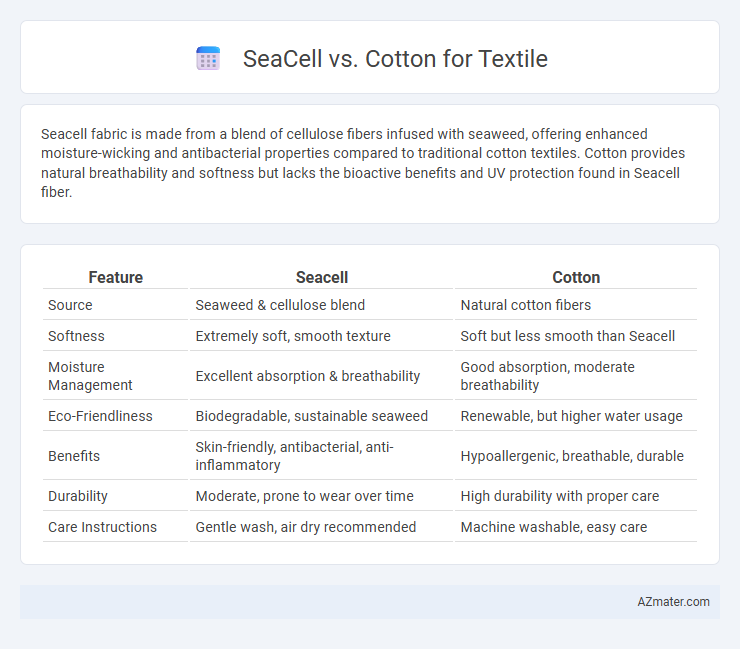Seacell fabric is made from a blend of cellulose fibers infused with seaweed, offering enhanced moisture-wicking and antibacterial properties compared to traditional cotton textiles. Cotton provides natural breathability and softness but lacks the bioactive benefits and UV protection found in Seacell fiber.
Table of Comparison
| Feature | Seacell | Cotton |
|---|---|---|
| Source | Seaweed & cellulose blend | Natural cotton fibers |
| Softness | Extremely soft, smooth texture | Soft but less smooth than Seacell |
| Moisture Management | Excellent absorption & breathability | Good absorption, moderate breathability |
| Eco-Friendliness | Biodegradable, sustainable seaweed | Renewable, but higher water usage |
| Benefits | Skin-friendly, antibacterial, anti-inflammatory | Hypoallergenic, breathable, durable |
| Durability | Moderate, prone to wear over time | High durability with proper care |
| Care Instructions | Gentle wash, air dry recommended | Machine washable, easy care |
Introduction to Seacell and Cotton
Seacell is an innovative textile fiber derived from natural cellulose combined with sustainably harvested seaweed, offering skin-conditioning properties and enhanced breathability. Cotton, a traditional natural fiber sourced from the seed hairs of the cotton plant, is renowned for its softness, durability, and moisture absorption. Both fibers serve distinct functions in textiles, with Seacell adding functional benefits through bioactive compounds and Cotton providing comfort and versatility in fabric applications.
Overview of Seacell Fiber
Seacell fiber, derived from a blend of cellulose and seaweed extract, offers unique benefits such as enhanced moisture absorption and natural skin-soothing properties, distinguishing it from traditional cotton. While cotton is highly breathable and widely used for its durability and comfort, Seacell integrates bioactive compounds that contribute to improved skin health and odor control. The incorporation of seaweed in Seacell provides sustainable advantages by utilizing renewable marine resources, making it an innovative alternative in the textile industry.
Cotton: Properties and Popularity
Cotton is renowned for its natural softness, breathability, and high moisture absorption, making it a preferred choice in textile manufacturing worldwide. Its hypoallergenic properties and durability contribute significantly to its popularity in clothing, bedding, and home textiles. The global market for cotton fibers remains robust due to sustainable farming advancements and consumer preference for natural, comfortable fabrics.
Environmental Impact: Seacell vs Cotton
Seacell fabric, derived from seaweed fibers combined with cellulose, offers a more sustainable alternative to conventional cotton by requiring less water, pesticides, and land for cultivation. Cotton production typically involves intensive use of water and agrochemicals, contributing to soil degradation and higher carbon emissions. The biodegradable nature of Seacell also reduces textile waste impact, enhancing its environmental benefits over traditional cotton textiles.
Comfort and Breathability Comparison
Seacell fibers, derived from seaweed-infused cellulose, offer superior moisture-wicking properties and enhanced breathability compared to traditional cotton. Cotton provides natural softness and comfort but tends to retain moisture longer, which can reduce overall airflow and freshness during wear. The integration of Seacell in textiles promotes a cooler, drier experience, making it an excellent choice for active or sensitive skin applications.
Moisture Management and Absorbency
Seacell fabrics exhibit superior moisture management compared to cotton due to their natural seaweed fibers, which enhance breathability and wick moisture away from the skin more efficiently. Cotton, while highly absorbent, tends to retain moisture longer, which can lead to a damp, uncomfortable feel during physical activities. The innovative properties of Seacell promote quicker drying times and better humidity regulation, making it ideal for performance and activewear textiles.
Skin-Friendly Features and Hypoallergenic Qualities
Seacell fabric, derived from seaweed and cellulose fibers, offers superior skin-friendly benefits by promoting moisture retention and providing natural antioxidants that soothe irritation, making it ideal for sensitive skin. Cotton, especially organic varieties, is highly breathable and hypoallergenic, reducing the risk of allergies and skin discomfort through its soft texture and moisture-wicking properties. Both textiles excel in hypoallergenic qualities, but Seacell's bioactive compounds provide enhanced skin nourishment compared to traditional cotton fibers.
Durability and Longevity in Textiles
Seacell fibers exhibit superior durability compared to traditional cotton due to their unique blend of seaweed and cellulose, which enhances tensile strength and resistance to wear. Cotton, while soft and breathable, tends to break down faster through frequent washing and exposure to sunlight. The longevity of Seacell textiles is significantly higher, making them ideal for sustainable and long-lasting apparel.
Cost and Availability in the Market
Seacell fabric, embedded with seaweed fibers, typically commands a higher price than traditional cotton due to its innovative production process and health benefits. Cotton remains widely available and cost-effective, benefiting from established global supply chains and large-scale cultivation. Market availability of Seacell is limited compared to cotton, which dominates the textile industry due to its affordability and accessibility.
Conclusion: Choosing Between Seacell and Cotton
Seacell offers exceptional moisture-wicking and antimicrobial properties derived from its seaweed cellulose composition, making it ideal for functional and eco-conscious textiles. Cotton remains a popular choice due to its breathability, softness, and widespread availability, but it lacks the advanced bioactive benefits found in Seacell fibers. Selecting between Seacell and cotton depends on the desired textile performance, sustainability goals, and specific end-use requirements.

Infographic: Seacell vs Cotton for Textile
 azmater.com
azmater.com